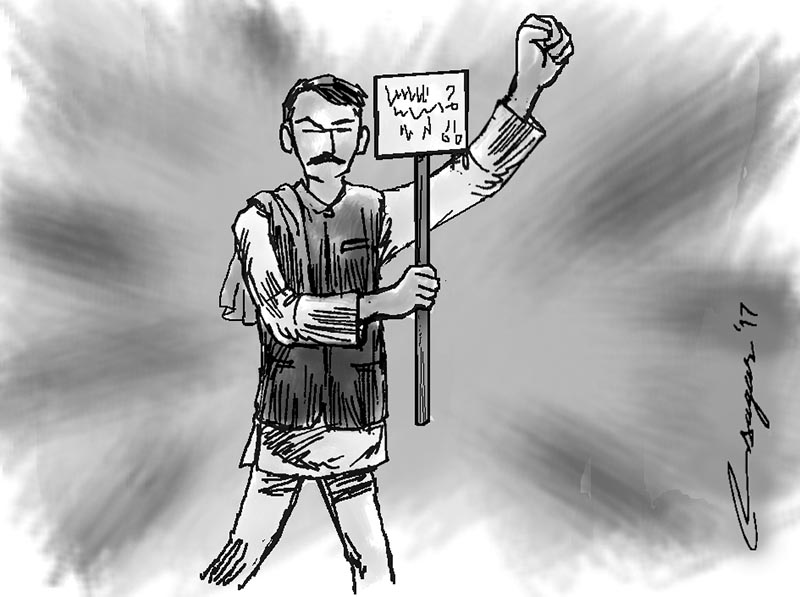Local level restructuring: Proportional representation
It is believed that had the present government wished to meet the demands of the Madhesi parties in this regard, it could have been done long back through the Local Level Restructuring Commission (LLRC) itself
The first phase of local level elections has been conducted in 34 districts for 283 units in provinces 3, 4 and 6 on May 14, 2017 peacefully, and in 41 districts, the second phase of elections for the rest of 461 units in provinces,No.1, 2, 5 and 7 are due to be conducted on June 28, 2017.
In view of the opposition by some Madhesi outfits, the date may be extended further to facilitate the parties to participate in the elections.
The concept of phase-wise election was introduced to differentiate between the unproblematic and problematic provinces where there is demand for restructuring of local units on the basis of proportional representation.
Thus, by holding peaceful elections in those provinces having no such demands, the government claimed credit for it.
The elections to the problematic provinces were separated from the original one phase election schedule with a view to buying time to negotiate the demands of those Madhes-based parties, which include amendment to the constitution and also negotiate the number of local level units in proportion to the population of 20 districts of Madhes/Tarai falling in these provinces.
The decision of the government to increase the number of the units on May 25, 2017 by 22 units in 12 district of Madhes bringing the total number of units to 766 and upgrade some units, just 19 days ahead of the second phase of election to persuade the Madhes based parties to participate in the election, was stayed by the apex court on May 26, 2017.
It is believed that had the present government wished to meet the demands of the Madhesi parties in this regard, it could have been done long back through the Local Level Restructuring Commission (LLRC) itself.
Against the previous 3,374 local level units (3157 Village Development Committees (VDCs) and 217 municipalities) where there were altogether 1,88,000 seats to be represented, including more than 45,000 seats for women, were reduced to just 36,654 seats including 13,360 seats for women.
As per the mandate, the LLRC proposed for 565 units on the basis of varying population.
For Village Councils (VC) it was 15,000 for the high mountain region, 25,000 for the hill region and 50,000 for the Tarai region. For municipalities it was 20,000, 35,000 and 75,000 for the different regions respectively.
The LLRC, however recommended only 744 units against the suggestions of the new government, which replaced the earlier one, for increasing the number of VCs to 927, treating Ilakas (area of a cluster of three to four VDCs) as the ‘main basis’ for fixing the number of VDCs.
The LLRC reduced the basis of population to 13,000, 22,000 and 40,000 respectively. Similarly, the population for municipalities too was reduced to 17,000, 31,000 and 60,000 for respective regions.
The above varying bases for fixing the numbers of local units deserve pondering over.
The problem seems to have its root in the new constitution itself that was jointly drafted and adopted by the Nepali Congress, the CPN-UML and the Maoist Centre, without taking the parties who were against the promulgation of the constitution on board.
In the Constituent Assembly (CA), these parties adopted the constitution through their vast majority.
Over and above, without considering the genuine need of proportional representations in Madhes which constitutes 50.03% of the total population of the country, for which the Madhesi and Janajatis were craving for, the then coalition government led by KP Sharma Oli constituted the LLRC with the mandate to limit the number of the local level units drastically.
The new government acted according to the previous government and accepted the reduced number of the units and declared the date for elections.
Notwithstanding many ways to make the LLRC accept reasonable basis for deciding the numbers of the local units, it simply overlooked the seriousness of the grievances of the Madhesi outfits.
It entails that neither the Maoist Centre, nor the CPN-UML nor even the Nepali Congress was in favour of justified increase in the number of the local units. However, these parties opted for having lengthy negotiations with the agitating parties to exhaust their patience and join the electoral fray ultimately.
Why is government, one after another, reluctant to consider the demand for proportional representation? If seats are increased in the Madhes region, the people of hill origin living in the region too will be equally benefited in their representation as they also have significant percentage of the population there.
Why should not there be a common basis for all the regions? Some leaders of these parties have drawn the criticism that they are reluctant to cede power to Madhesis, Janajatis and other marginalized communities. These leaders do not want the acceptability of the new constitution to be broadened.
Certain groups, who have control over the administration, do not want to share power with others.
Some politicians seem to be taking a line on the issue in view of their grip on power on the political course of the region.
Such personal interests need to be rationally analyzed and overcome in the interest of the nation.






